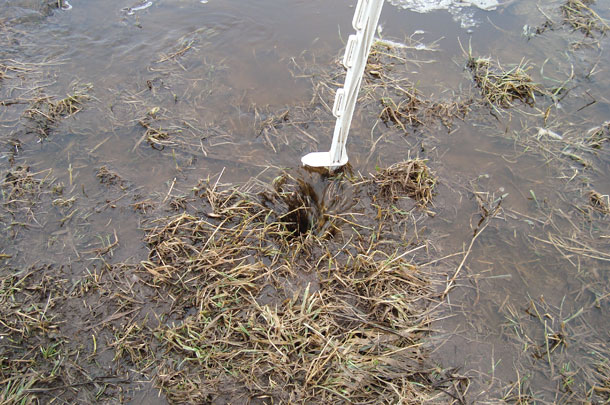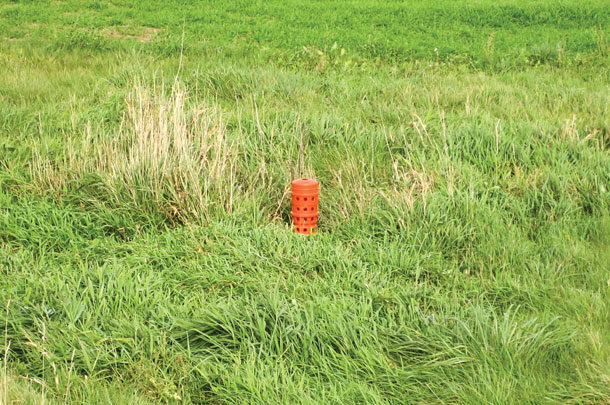Manure and tile are both important tools for improving the productivity of our farms. Manure as an organic nutrient source is a tremendous benefit to crops and soils, and tile improves crop growth in poorly drained soils.
Liquid manure applications to tiled lands, however, pose some unique management challenges. Tiles are designed to remove excess moisture from the soil. If we don’t take the necessary management precautions, liquid manure can find its way into the tiles and out to surface waters. Here are some management steps to take to ensure manure and its nutrients stay out of tile systems.
1. Understand tile system components and how they impact manure applications
The first step to keeping manure out of tiles is to know where your tiles are. While it can be difficult to locate the buried portion of a tile system, the outlets and surface inlets (if it has any) can be found relatively easily. Locating the outlets and inlets is essential for conducting tile maintenance and taking precautions for manure applications.
Tile outlets and surface inlets should be inspected at least annually for blockages. Vegetation, animal nests and other debris can clog inlets and outlets, compromising the effectiveness of a system.
Fields should also be inspected for tile blowouts. Tile blowouts occur when a weak point in the tile ruptures or collapses, creating a hole from the tile to the soil surface. Manure applied to a field with blowouts will be able to move directly into a tile, causing water quality impairments.
Precautions also need to be taken in fields with tile surface inlets. The surface inlet, like a blowout, is a direct pathway for manure to reach the tile. Leaving a buffer around surface inlets during manure applications will reduce the risk of manure entering the tile.

2. Assess weather and soil conditions prior to manure application
When applying liquid manure on tiled fields, the goal is to put the manure into the soil but not into the tile. To do this, we have to pay careful attention to the weather and soil conditions. If rain is forecast within three days of application, it is wise not to spread.
Soil moisture is a very important factor in deciding whether to spread or not. Follow the Goldilocks principle; soils shouldn’t be too wet or too dry. Be cautious of fields with moist soils. A liquid manure application is essentially a rainstorm.
A 14,000-gallon manure application is equivalent to a half-inch rainfall. If the soil is already wet, the addition of manure could trigger tile flow. Before applying manure, check the tile outlets on the fields to be spread on. If the tile is flowing, do not spread. Any additional liquid, like manure, will likely flow into the tile.
Excessively dry soil conditions are also a hazard. Dry soils can develop cracks that can actually be deep enough to reach the soil. These cracks become preferential flow paths, and liquid manure spread on these soils can flow straight down the cracks into the tile.
A split application of a light rate of manure to swell the cracks shut, followed later by a heavier application, will remedy the problem.
Preferential flow paths are also a concern in no-till and perennial crop fields. Soils in these fields often have well-defined macropores, root channels and worm burrows that act as flow paths for water, and thus liquid manure, to quickly enter tiles.
Split applications of low manure rates can help keep manure out of tiles. In some cases, pre-tillage or tillage concurrent with manure application may be necessary to break up preferential flow paths.
3. Follow nutrient and conservation best management practices
Always apply manure and nutrients according to regulatory guidelines and follow an approved nutrient management plan. Manure and nutrients applied at the proper rate, place and time are less likely to end up moving into tiles.
However, just because your nutrient management plan says you can apply 20,000 gallons per acre on a field doesn’t mean the soil can handle that much manure at one time. Always refer back to your assessment of soil conditions before applying manure.
Conservation practices that protect soil on the surface also help reduce manure and nutrient losses to tile. Conservation systems and practices like no-till, cover cropping and grassed waterways reduce runoff, soil and nutrient movement, helping keep them away from tile surface inlets.
Additionally, some of the nutrients in manure applied to a living cover-cropped field will be captured in those living plants to be released the following year when the plant decomposes. Cover crops have been found to be effective at reducing nitrate losses to tiles.
4. Emergency plan
Monitor tile outlets before, during and after manure applications. If manure does make its way into the tiles, you will be able to detect it at the outlet. In the event of manure entering a tile, have an emergency plan in place.
You can attempt to block the outlet or dam up the outflow to protect waterways. You could intersect the tile system and dig a pit to collect the manure. If you have a water control structure, insert the stop logs to hold back the flow.
All of these are viable options to mitigate a manure spill to a tile, but you won’t be able to do any of them quickly if you haven’t prepared for such a contingency. Finally, if you have a spill, call your local environmental emergency response hotline to report the spill and get assistance with subsequent remedial actions.
Manure applications and tile systems don’t have to be mutually exclusive. With careful preparation and attention to soil and weather conditions, we can safely apply manure to tiled fields. For more information about managing tiled lands, visit online (Tile Drainage Resources - Cooperative Extension). ![]()
PHOTO 1: Surface inlets should be inspected at least annually for blockages. These inlets can allow manure to directly enter tiles. A buffer area should be left around each inlet.
PHOTO 2: Tile blowouts occur when a weak point in the tile ruptures or collapses, creating a hole from the tile to the soil surface. Manure applied to a field with blowouts will be able to move directly into a tile, causing water quality impairments. Photos provided by Aaron Pape.
Aaron Pape is with the University of Wisconsin Discovery Farms. Email Aaron Pape.








